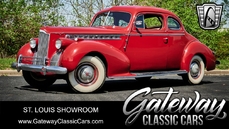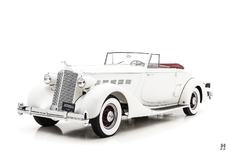Packard Super Eight 1939
Allgemeine Beschreibung :
By 1939 Packard, Lincoln, and Cadillac shifted much of their focus to the competitive mid-priced market as high-end luxury sales lagged. A consequence of this shift was that many of the great American coachbuilders that relied upon wealthy clientele had closed their doors. Dietrich and LeBaron had been sold, both reduced to little more than brand-names while Brunn was not far behind. Derham Body Co. of Philadelphia, however, was picking up the slack and remained a strong presence in the industry, so they became a natural choice for the remaining Packard buyers who desired bespoke coachwork. While the focus was heavily on the junior One-Twenty line, sales of the prestigious Super Eight and Twelve still trickled on. In mid-1939, three new 148-inch wheelbase, export specification Model 1704 Super Eight Touring Limousines were sent directly from Packard to Derham. The cars were then converted to open Phaeton specification by special order. It is assumed that the Super 8 was chosen over the arguably more prestigious Twelve for its robust nature and ease of service. According to the widow of Enos Derham, one of the three was sent to Canada for use in an official visit by the British Royal Family, and another sent to a Middle Eastern nation.
Featured here is the third of these very special and fascinating Packards. Serial number B502752 was built to special order for the Argentine Government, then under the control of Roberto Maria Ortiz. Upon its export to Argentina, it is believed to have received some further modifications for state use by a local coachbuilder, such as fitment of the three-piece rear windscreen assembly and some additional interior appointments. This unique Packard remained in the hands of the Argentine State for many years, which, during this tumultuous time, meant several more presidents. The most famous of all to use this Packard was Juan Perón, who rose to power in the late 1940s, assuming the office of President in 1946. Juan Perón and his captivating wife Eva, endearingly known as Evita, were both lauded and loathed during their time in office. Impassioned supporters saw Evita, in particular, as a spiritual leader of the nation and champion of the working class. Her followers adored her and, even some 66 years after her untimely death, her legacy continues to inspire millions of followers.
During the Perón regime, Juan and Eva used this unique Packard for official events and were photographed in the car on several occasions. A particularly intriguing image in the history file shows Evita standing in the back, alongside her husband, dressed in a large fur coat. Despite her smiling and waving to the crowd, she was gravely ill with uterine cancer and concealed beneath her coat was a body cast that allowed her to stand in her severely weakened state. This would prove to be her last public appearance, as Evita Perón died just a few weeks later in 1952. By 1955, Juan was deposed as president and sent into exile, and the Packard disappeared.
So polarizing were Juan and Evita that some Argentinians sought to destroy anything related to the Perón legacy, so it is quite remarkable that something as bold and big as this Packard parade car managed to survive. It was discovered in Argentina in the late 1970s, hidden in a barn and in rough but complete condition. American Sam Sherman uncovered it, but he failed to obtain an export license. Soon after, Argentine broker Hector Mandizabal successfully exported the car, and it came to the United States late in 1977, finding new ownership in Nebraska with Herman Zalud. By 1981, this amazing Packard was sold to Bill St. Clair of Texas who treated it to a cosmetic restoration. Mr. St. Clair extensively researched the history, corresponding with the Argentine government and with the great Packard historian Beverly Rae Kimes to authenticate it. The Packard was shown at several CCCA Events and earned a First Prize, Primary Division at the 1982 Southwest Grand Classic.
In 1983, it was sold via Leake Auction, and bought by Raymond Plaster. Mr. Plaster further researched the car’s history, and he and his wife eventually set about performing a nut-and-bolt, body off restoration. Great attention was paid to authenticity, with the official state seal recreated on the doors, “Armourplate” markings on the rear glass, parade flags fitted to the bumper and many other details. Items such as the rear compartment clock, with its period Argentinian label, served to corroborate the fascinating story of this singularly remarkable Packard.
Today, it is presented as-restored by the Plasters, looking particularly regal in dark blue lacquer over red leather. The paint remains glossy and quite attractive, though it has taken on a mild patina in some places, with some cracking and fading of the lacquer evident. Fitment of the doors is excellent, thanks to the carefully restored woodwork beneath the steel skin. Chrome trim is similarly well-presented, and the body is accessorized with dual sidemount spares, a goddess of speed mascot and Senior Trippe lights, presumably added during the restoration.
The interior is especially marvelous, with intricate woodgrain work on the dash and the fabulous four-spoke steering wheel. Set into the dash are ornate, beautifully restored “phone-dial” instruments with metric calibration. 1939 saw the debut of Packard’s new “Hand Shift” column-mounted gearlever, and, for this right-hand drive car, the lever is bent in an S-pattern to allow for proper operation of the gearbox. Beautiful woodwork graces the rear compartment, which retains the original clock fitted at the Argentine coachbuilder, Ataun Goia. The red leather has a subtle antique pattern to it, and it remains in very fine condition, with moderate character acquired from years of gentle use and care. In addition to the full black canvas top, a set of side curtains is also included.
Mechanically it is in good working order, and the presentation is consistent with this being a high-quality, older restoration. It has been shown on numerous occasions in CCCA and Packard club events, and it featured as a cover story in the spring 2004 issue of the Packard Cormorant. Accompanying the sale is a generous binder of documents and correspondence that corroborate the fascinating story of this truly unique Packard. One of the last of the grand coachbuilt Packards, this marvelous Super Eight Phaeton by Derham is sure to be favored by its next keeper, much as it was by Evita Perón.
https://hymanltd.com/vehicles/6312
1939 Packard Super Eight is listed verkauft on ClassicDigest in St. Louis by Mark Hyman for $229500.
Fakten der Auto
Karosserietyp : Auto Marke : Packard Modell : Super Eight Hubraum : 0.0 Modelljahr : 1939 Karosstyp : Convertible Lage : Missouri
Verkauft
Angaben Zum Verkäufer
Verkauft
People who viewed this Packard Super Eight also viewed similar Packard listed at ClassicDigest
Other cars listed for sale by this dealer
über Packard
Packard: Eine umfassende GeschichteFrühe Jahre und Stiftung:
Gründung: Die Packard Motor Car Company wurde 1899 in Warren, Ohio, von James Ward Packard, William Doud Packard und George Lewis Weiss gegründet.
Pionierluxus: Packard produzierte zunächst hochwertige Automobile und wurde zum Synonym für Luxus, Handwerk und technische Exzellenz.
Bemerkenswerte Erfolge und Beiträge:
Packard Twin Six: Das 1916 eingeführte Auto wurde Packard als Premier Luxury Automobile Marke eingerichtet.
Modelllinienerweiterung: Packard hat seine Aufstellung mit verschiedenen Modellen erweitert, darunter Limousinen, Coupes, Cabrios und Limousinen, die an wohlhabende Kunden geliefert werden, die Eleganz und Leistung suchen.
Engineering Innovations: Die Marke führte mehrere Innovationen ein, z.
Zehn historisch bedeutende Modelle mit technischen Spezifikationen:
Packard Twin Six (1916):
Motor: 7.3L V12 Motor.
Leistung: rund 85 PS.
Packard acht (1930-1938):
Motor: Straight-8 Motor mit verschiedenen Verschiebungen.
Leistung: reicht zwischen 90 und über 130 PS.
Packard Super Eight (1939-1951):
Motor: Straight-8 Motor.
Leistung: Produktion zwischen 130 und 180 PS.
Packard One-Twenty (1935-1942):
Motor: Straight-8 Motor.
Leistung: ca. 100 bis 120 PS.
Packard Clipper (1941-1957):
Motor: V8 Motor.
Leistung: reichen von 135 bis 185 PS.
Packard Caribbean (1953-1956):
Motor: V8 Motor.
Leistung: variiert zwischen 275 und 310 PS.
Packard Patrician (1951-1956):
Motor: Inline-8- und V8-Motoren.
Leistung: reicht von 150 bis 180 PS.
Packard Hawk (1958):
Motor: V8 Motor.
Leistung: Erzeugt um 275 PS.
Packard Executive (1956-1958):
Motor: V8 Motor.
Leistung: variiert zwischen 240 und 290 PS.
Packard Predictor (1956):
Motor: Konzeptauto präsentieren Design und Technologie.
Leistung: Prototypmodell.
Vermächtnis und Einfluss:
Qualität und Eleganz: Packard wurde wegen seiner außergewöhnlichen Verarbeitungsqualität, des raffinierten Stylings und seiner Luxusmerkmale verehrt, die häufig mit europäischen Luxusmarken wie Mercedes-Benz auf A-A-Niveau berücksichtigt wurden.
Produktionsende: Die Marke hatte in den 1950er Jahren finanzielle Kämpfe, was zu ihrer Fusion mit Studebaker und letztendlich Ende der 1950er Jahre führte, was das Ende einer Ära in amerikanischen Luxusautomobilen kennzeichnete.
Packard hinterließ ein dauerhaftes Erbe in der Automobilindustrie, symbolisierte Eleganz, technische Exzellenz und ein Engagement für Luxus, das weltweit von Autoenthusiasten bewundert und respektiert wurde.









